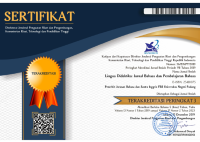An Analysis of Slang Used on Prawirotaman Street, Yogyakarta
 ), Afan Setiawan(2),
), Afan Setiawan(2), (1) Universitas Mercu Buana Yogyakarta
(2) Universitas Mercu Buana Yogyakarta
 Corresponding Author
Corresponding Author
Copyright (c) 2022 Lingua Didaktika: Jurnal Bahasa dan Pembelajaran Bahasa
DOI : https://doi.org/10.24036/ld.v16i1.116932
Full Text:
 Language : en
Language : en
Abstract
This Paper discusses about the analysis of slang that is used by western tourist in Prawirotaman Street in Yogyakarta. The purpose of this study is to find out the types and meaning of slang primarily used by western tourists. It uses a qualitative description method where it describes slang that is used by western tourists. Theory of Eric Partridge (2004) in types of slang is used to indentify the slang. Three types of slang are commonly used by the western tourists on Prawirotaman Street, Yogyakarta and 15 reasons are found. Therefore, the research has implications for the reader to have and apply their knowledge about slang in informal context of daily communication especially in certain tourism area contexts. It also enriches reader’s linguistic feature that can enhance their communicative skills since the social functions of the language are learnt.
Keywords
References
Agha, A. (2015). Tropes of slang. Signs and Society, 3(2), 306–330. https://doi.org/10.1086/683179
Alawiyah, S., Zuriyati, & Lustiyantie, N. (2021). Slang Language as Representatives of Social Culture Identity in Film Step up 2 The Streets. IJLECR - INTERNATIONAL JOURNAL OF LANGUAGE EDUCATION AND CULTURE REVIEW, 7(2), 204–213. https://doi.org/10.21009/IJLECR.072.20
Amir, K., & Azisah, St. (2017). Gender Analysis on Slang Language in Students Daily Conversation. ETERNAL (English, Teaching, Learning, and Research Journal), 3(2), 229–243. https://doi.org/10.24252/ETERNAL.V32.2017.A10
Ayto, J., & Simpson, J. (2010). The Oxford Dictionary of Modern Slang. In The Oxford Dictionary of Modern Slang (2nd ed.). Oxford University Press. https://doi.org/10.1093/ACREF/9780199543700.001.0001
Budiana, N., Didik, ;, & Setiyoko, T. (2021). Students’ Slang Language in WhatsApp on Effective Sentences: Sociolinguistics Review. International Journal of Multicultural and Multireligious Understanding, 8(1), 373–382. https://doi.org/10.18415/ijmmu.v8i1.2248
Gemilasari, N., & al Hafizh, M. (2013). An Analysis of Word Formation of Slang Words Found in Short Stories in Teenager Magazines Aneka Yess! English Language and Literature E-Journal, 2(1), 142–148. http://ejournal.unp.ac.id/index.php/ell/article/download/2403/2015
Ochonogor, W. C., Alakpodia, N. O., & Achugbue, I. E. (2012). The Impact of Text Message Slang (Tms) or Chartroom Slang on Students Academic Performance. International Journal of Internet of Things, 1(2), 1–4. https://doi.org/10.5923/j.ijit.20120102.01
Partridge, E. (2004). Slang-To-Day-And-Yesterday. Routledge and Kegan Paul Ltd.
Rasekh, A. E., & Shahraki, S. H. (2011). Check This One out: Analyzing Slang Usage among Iranian Male and Female Teenagers. 4(2). https://doi.org/10.5539/elt.v4n2p198
Rosita, F. Y. (2016). Ekspresi Penerimaan Dalam Dialog antar Penghuni Kos (Kajian Pragmatik). 23 23 Farida Yufarlina Rosita, Ekspresi Penerimaan Dalam Dialog Antarpenghuni Kos (Kajian Pragmatik) 23 KEMBARA: Jurnal Keilmuan Bahasa, Sastra, Dan Pengajarannya, 2(1), 23–30. https://ejournal.umm.ac.id/index.php/kembara/article/view/4040/4427
Setyawan, A. H. (2021). Flouting Maxim on English Radio Program in Yogyakarta. ELTICS : Journal of English Language Teaching and English Linguistics, 6(1). https://doi.org/10.31316/eltics.v6i1.1075
Smith-Hefner, N. J. (2007). Youth Language, “Gaul” Sociability, and the New Indonesian Middle Class on JSTOR. Journal of Linguistic Anthropology, 17(2), 184–203.
Spolsky, B. (2004). Sociolinguistics. Oxfod University Press. https://library.ablaikhan.kz/wp-content/uploads/2022/01/Sociolinguitics-Bernard-Spolsky.pdf
Yeshivia. (n.d.). The Form, Function and Meaning of English Slang Used by Members of Bali Hip-Hop Community. Humanis, 5(3), 1–8. Retrieved April 26, 2022, from https://ojs.unud.ac.id/index.php/sastra/article/view/7108/5369
Zare, P. (2012). Language Learning Strategies Among EFL/ESL Learners: A Review of Literature. In International Journal of Humanities and Social Science (Vol. 2, Issue 5).
Zhou, Y., & Fan, Y. (2013). A Sociolinguistic Study of American Slang. Theory and Practice in Language Studies, 3(12), 2209–2213. https://doi.org/10.4304/tpls.3.12.2209-2213
 Article Metrics
Article Metrics
 Abstract Views : 796 times
Abstract Views : 796 times
 PDF Downloaded : 308 times
PDF Downloaded : 308 times
Refbacks
- There are currently no refbacks.
Copyright (c) 2022 Lingua Didaktika: Jurnal Bahasa dan Pembelajaran Bahasa

This work is licensed under a Creative Commons Attribution-NonCommercial 4.0 International License.









